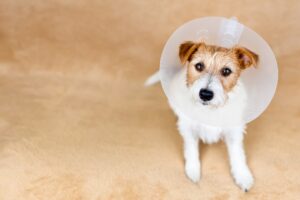
Spaying and neutering your pet matters, but don’t overlook post-surgical care!
Spaying or neutering your pet is a great way to be a responsible pet owner. Both cats and dogs can deal with additional health risks and of course the possibility of creating more litters than your community has the means of providing for. As a pet owner, you will need to prepare for post-surgical care. Here are the best ways to care for your pet after spaying or neutering.
Help Your Pet Recover from Anesthesia
The first step is to help your pet recover from the anesthesia. Your pet might feel the effects for up to two days after the surgery. These effects could include pain, nausea, balance issues, sleepiness, and moodiness. If your pet is glassy-eyed, vocal, or shivering, do not be alarmed.
You can help your pet recover in these first two days by:
- Encouraging it to move around gently but frequently to shake off the anesthesia
- Feeding small amounts of food at a time to combat nausea
- Give your pet water later on in the day
- Create a quiet, safe, and comfortable environment for healing
- Keep an eye on the surgical area for signs of notable inflammation or bleeding
Care for Your Pet 10-14 Days after Surgery
Limit Physical Activity
Once your pet has recovered its sense of self and appetite, it should rest up for 10-14 days. Do not let it engage in strenuous activity or go on long walks. In fact, it is probably better to do without walks during this time. Also, do not bathe your pet or let it go swimming or play in snow.
Monitor the Incision Site
Keep an eye on the incision site. A little bleeding, swelling, and redness is normal. Call the vet if there is pronounced bleeding and inflammation or if your pet has lost its appetite, is unresponsive, or is continually vomiting. Checking the incision site twice a day should be sufficient.
Protect the Surgical Site
Do not let your pet lick or otherwise bother the surgical area, as it will risk significant problems. Have your pet wear an Elizabethan collar, also known as an E-collar or E-cone. The cone should fit well around the neck and extend two inches beyond your pet’s nose. If your pet will not wear the E-collar, a modified onesie for females or boxer shorts for males also works.
Contact Your Vet If You Have Concerns
Your vet should give you a written guide on caring for your pet after spaying or neutering after the surgery. If you have any questions or concerns, don’t hesitate to call your local vet!
Trust the Care of Your Pet to the Professionals at Everhart Veterinary Medicine!
At Everhart Veterinary Medicine, our veterinary professionals strive to provide your pet with the very best of veterinary care. We believe that the best care for your pet should be provided by experienced, compassionate, and knowledgeable veterinary professionals. With three Maryland locations in Baltimore, Pasadena, and Cross Keys, we are always ready to welcome your pet as a new patient! Give us a call today at 410-355-3131, 410-793-7670, or 443-470-6790! For more information, as well as updates on veterinary news and topics, visit us on Facebook, Twitter, or LinkedIn!
